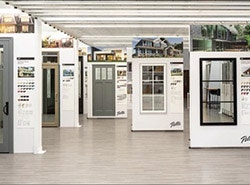Top Factors to Consider for Energy-Efficient Windows
If you want to save energy and money, find out the six things you need to think about when selecting the best energy-efficient windows for your home.

KEY TAKEAWAYS
- Energy-efficient windows can significantly reduce heating and cooling costs, improve comfort, and lower a home's carbon footprint.
- Key factors for efficient windows include high-performance glass, proper installation, strategic placement, suitable frame materials, and climate-specific designs.
- Look for ENERGY STAR® and NFRC-rated windows with low U-Factor and SHGC values for optimal insulation and solar control tailored to your region.
Improving a home’s energy efficiency is one of the top reasons homeowners choose to replace or update their old windows. Energy-efficient windows not only make your home more comfortable year-round, but they can also help homeowners cut down on utilities, saving both energy and money.
Benefits of Energy Efficient Windows
By using energy efficient windows, your home will be positively impacted. Explore the three ways these windows can benefit you in the long term.
- Cost Savings: Reduce your energy bill with better insulation. Energy efficient windows help lower your heat loss and gain.
- Increased Comfort: Stable temperatures call for less HVAC use. Windows that prioritize energy efficiency reduce drafts and leaks in your home.
- Environmental Impact: Lower your carbon footprint by reducing your overall energy consumption. You can even be subject to tax credits or rebates by using energy efficient products.
What Makes a Window Energy Efficient?
When shopping for energy-efficient new or replacement windows, keep these six things in mind:
1. Energy-Efficient Glass
A key component of any window is its glass. The right window glass option, optimized for your climate, can help reduce heating and cooling costs by slowing thermal transfer. With dual-pane or triple-pane glass, inert argon gas can be used between panes of glass to improve insulating properties. Laminated, tempered, tinted and obscure insulating glass can also add ultraviolet protection to help keep your home more comfortable and energy efficient.
In addition to energy-efficient glass, keeping curtains, shades and blinds open on sunny winter days is another way to improve window energy savings. On colder winter days, closing your drapes can help insulate your home.
2. Window Installation
Proper window installation will help prevent air infiltration and even costly water damage to your home. If installed incorrectly, your windows may not operate properly. Check the level, plumb, bowing, square and the reveal to determine if your windows were installed properly. A tightly sealed and properly installed window helps prevent air leaks and drafts, which can help reduce heat loss and increase comfort in your home.
3. Window Placement
You can increase your window's energy efficiency by selecting specific low-emissivity (Low-E) glass coatings for different areas of your home. These are layers of thermal protection inside insulating glass that help:
- Reflect summer heat and retain interior cooling
- Reflect winter cold and retain interior heat
- Block harmful UV rays to help prevent fade damage
4. Region
Your home’s geographic location and climate help determine the best energy-efficient windows for your region. Depending on your region, during the winter, heating your home can be one of your largest utility expenses. The higher you set your thermostat, the higher your energy costs. MidAmerican Energy Company recommends heating your home to 68 degrees Fahrenheit in the wintertime. In fact, MidAmerican Energy Company shares that dropping your home’s temperature by “just two degrees can save … you over 8% on your energy bill,” especially in a tightly sealed home with energy-efficient windows.
5. Window Frame Construction
Your choice of window frame material influences your window’s overall energy efficiency.
- Wood windows provide excellent insulation. Wood has low conductivity which means wood window frames transfer less heat or cold into your home.
- Our proprietary fiberglass material offers insulating properties similar to wood. Durable fiberglass windows are made from a thermoset material, meaning it won’t melt or breakdown when exposed to environmental temperature swings. Pella’s fiberglass is the strongest material available for windows, engineered for lasting durability.9
- Multi-chambered vinyl window frames reduce heat loss for added energy efficiency – and they’re exceptionally easy to care for. Multiple air-filled chambers have insulating properties to slow the transfer of heat.
All Pella windows are available in energy-efficient wood, fiberglass and vinyl options, so you can choose the material that is best suited for your home. Some products are available with optional foam insulation to further improve energy performance.


Window Energy Labels and Metrics
To choose energy-efficient windows with confidence, it’s important to understand the key metrics used to rate their performance. Information can often be found on the window’s energy label. Look for products that feature the ENERGY STAR® label, which means the window has met strict energy efficiency standards set by the U.S. Environmental Protection Agency. These windows are also tested and rated by the National Fenestration Rating Council (NFRC) to ensure consistent performance measurements across products.
ENERGY STAR® Windows
ENERGY STAR® is a voluntary program through the U.S. Environmental Protection Agency's (EPA) that helps businesses and individuals save money and protect our climate through superior energy efficiency. An ENERGY STAR® window means the government has certified that the product meets or exceeds energy performance standards in your state.1
Replacing single-pane windows with ENERGY STAR® certified windows can help homeowners across the United States reduce their annual heating and cooling costs by 12% on average.
NFRC Energy-Rated Windows
The National Fenestration Ratings Council (NFRC) is a nonprofit organization for the window industry that developed an energy rating system based on whole-unit product performance – not just glass performance. It's the only reliable way to determine the entire window’s energy performance and compare products side-by-side.
The NFRC label provides several energy ratings that can help you compare window options:
- U-Factor (0.20–1.20): Measures how well a window insulates. The lower the number, the less heat escapes your home—ideal for cold climates.
- Solar Heat Gain Coefficient (SHGC) (0–1): Indicates how much solar heat enters through the glass. Lower values mean better performance in hot, sunny climates.
- Visible Transmittance (VT) (0–1): Tells you how much natural light enters through the window. Higher values mean more daylight and less need for artificial lighting.
Additional performance ratings on the label may include:
- Air Leakage (≤ 0.3): Represents the amount of air that passes through the window frame. Lower values mean fewer drafts and better overall efficiency.
- Condensation Resistance (1–100): Shows how well the window resists moisture buildup. Higher numbers indicate better resistance to condensation.
Understanding these metrics can help you select windows that perform best in your region and meet your home’s comfort needs. For the greatest energy savings, choose windows with low U-Factor and SHGC values, and high VT—especially when tailored to your climate.
Maximize Your Efficiency with the Right Ratings
By being mindful of performance values like U-Factor, SHGC, and VT, you can lower heating and cooling costs while improving comfort and natural light. Pairing this knowledge with the ENERGY STAR® and NFRC labels ensures you’re getting windows that deliver on both performance and energy savings.


